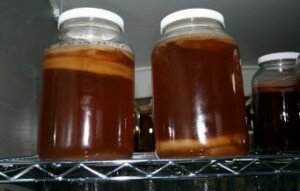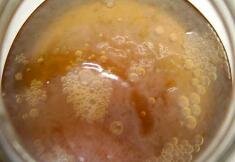Q. My package is expanded during shipment. Is it still good?
A. Nothing is wrong with the culture starter and this happens normally during shipment. It’s a good sign, meaning the kombucha ‘mushroom’ culture is viable and living. Remember this is live and active cultures of yeast and bacteria your working with.
Best to open the package and place in a clean jar with lid, until use. Make sure to get your first batch going ASAP!

culture has sunk to the bottom while the
other kombucha culture is at the top.
Note that both containers are forming a
new mushroom on top of the tea solution.
Q. Just made the first batch of kombucha tea and the starter mushroom sinks to the bottom. Is it bad?
- Nothing is wrong, if your kombucha culture mushroom sinks when placed in the new tea solution. After a few days and with the build up of CO2, the culture will in most cases rise to the surface. When selecting which cultures to brew your new batch of tea with choosing a mushroom culture that floats will help jump start the brewing process and provide an extra level of protection. If the culture floats then the tea starts culturing from the top down. When a culture does sink, the culture growth works from the bottom up. Even if the mother culture does not start to float, do not worry, as the new culture layer will always form on the top of the tea solution. This is one reason to add ‘starter tea’ when making a new batch to aid in inoculating the tea solution.

Q. My finished Kombucha tea has no effervescence. How can I make it fizzy?
A. People in the USA are custom having fizzy drinks and the finished kombucha or Jun beverage, making little bubbles as it is poured into a glass, is what one desires.
A few things are easy to change yet effect the outcome of the finished product…
Temperature is the number one factor in producing effervescence. If the temperature is to low or high, the amount of carbonation varies. A temperature of 75 to 80 deg F does the trick in most cases.
Yeast change sugars into alcohol, producing carbonation as a side effect. Happy yeast colonies make more fizz! Adding a bit more sugar or trying a different type could help add more fizz. However, just adding more sugar won’t always do the trick. Too much sugar can make the yeast sluggish and slow. Like people after the ‘all you can eat buffet’
Try Changing Tea type of tea you use. Aged or black teas seem to produce more carbonation.
We also find that having more than one mother culture in a jar seems to seal it off better. This holds in more carbonation, which one can see being released as the kombucha culture is removed.
 Q. I think I have mold on the tea culture…what do I do?
Q. I think I have mold on the tea culture…what do I do?
Mold on the kombucha mushroom culture is a common question we are asked here. What does mold look like compared with the dying yeast cultures that are common during the kombucha or JUN brewing cycle? A simple answer is that most mold or foreign growth will look like mold that occurs on other type of food such as bread or cheese. Most will be fuzzy and brown or green in colour. Any type of mold or fungus growing on top of the kombucha mushroom is cause to discard the whole mushroom culture due to contamination. See our older Blog post for more on kombucha and mold.
What is Not Mold: Sometimes the culture will produce brownish streamers or what is described as a string or web-like in appearance or growth, which hangs down into the tea. This is not mold or contamination and are simply old, dead yeast cells that have completed their life cycle.
These are fine to consume, however, many people like to strain these out before bottling the finished beverage. Sometimes the mushroom itself will form a brown area by the edge of the glass, which may look like mold. This must be examined closely as this, too, may simple be dead kombucha yeast cells. At other times, the mushroom culture will develop whitish coloured bumps on the surface of the liquid. These are sometimes mistaken for mold; however, they are simply small bubbles of carbonic acid just under the newly developing skin. The new culture will continue to fill out and cover these within a few days. But most important, if you are unsure of anything or suspect something is wrong! Do NOT Drink the Tea!
Thanks for checking out the Blog page and Happy Culturing!
Live, Grow, Share Cultured Foods
Checkout our culture specials this weekend at our store page.
We have some free kombucha cultures with certain orders.
See details at the Organic-Cultures Store
